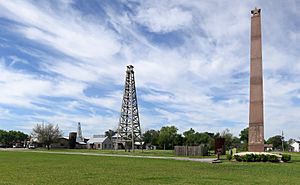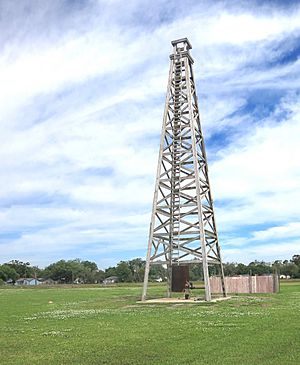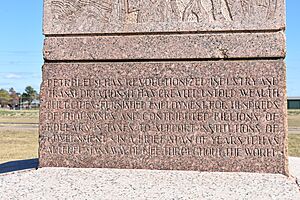Spindletop-Gladys City Boomtown Museum facts for kids
 |
|
| Lua error in Module:Location_map at line 420: attempt to index field 'wikibase' (a nil value). | |
| Location | 5550 Jimmy Simmons Drive, Beaumont, TX 77705 |
|---|---|
| Type | History Museum |
| Owner | Lamar University |
| Public transit access | (BMT) Route 7 -Virginia and Rolfe Christopher |
| Nearest parking | Free parking at site |
The Spindletop-Gladys City Boomtown Museum is in Beaumont, Texas. It celebrates the amazing discovery of oil at Spindletop Hill. This happened on January 10, 1901. This oil find started a huge "oil boom" in Texas. This boom changed Texas forever.
The museum has a gift shop with cool souvenirs. You can also see historical shows put on by local actors. There's a copy of the tall wooden oil derricks that once covered Spindletop Hill. These were used to drill for oil a long time ago. For special events, the museum staff even "blows the gusher." They use water and sound effects to show what it was like when the oil first shot out of the ground!
The museum is part of Lamar University. The university owns and runs the museum.
Contents
The Spindletop Oil Boom
The name "Spindletop" was used even before the Civil War. It was a small hill south of Beaumont, Texas. Some people think it got its name because heat waves made the trees on the hill look like a spinning top. Many ghost stories were told about Spindletop Hill. People often saw St. Elmo's fire there at night. This is actually just static electricity. The oil at Spindletop was found in a "salt dome." This is a big underground dome made of salt.
Searching for Oil
In 1889, a young man from Beaumont named Pattillo Higgins became very interested in Spindletop Hill. He thought there might be a lot of oil hidden there. Higgins taught himself about geology. He studied the land and saw signs that made him believe there was plenty of cheap fuel at Spindletop.
Another person, Captain George Washington O’Brien, also thought there was oil at Spindletop Hill. He had known about it since 1865. He bought over 1,000 acres of land there in 1888. Higgins convinced his friend George W. Carroll to buy another large part of the land.
In 1892, Higgins and Carroll decided to work together. They started the Gladys City Oil, Gas and Manufacturing Company. This was one of the first oil companies in Texas. Their plan was to find oil. Then they wanted to use the oil to build a perfect industrial city called Gladys City. Higgins named the town and company after a student in his Sunday school class, Gladys Bingham.
Early Drilling Attempts
The Gladys City Company tried to drill for oil on Spindletop Hill in 1893. They did not find any oil. They tried again in 1895 and 1896. Each time, they failed because they didn't have the right equipment. Higgins left the company in 1895. He had promised to make his partners rich, but they started to lose hope. People even joked about Higgins, calling him the "Millionaire."
An engineer from Austria, Captain Anthony F. Lucas, heard about Spindletop Hill. He had been working on salt mines in Louisiana. He visited Beaumont and became sure there was oil at Spindletop. He leased land from the Gladys City Company in 1899. His first try failed, and Lucas almost gave up. But his wife told him to find more money and try again.
Lucas went to two famous oil drillers from Pittsburgh, James Guffey and John Galey. They were interested in Lucas's idea. They asked Andrew Mellon for money to keep drilling.
The Lucas Gusher
Guffey and Galey hired the Hamill brothers, Al and Curt. They were the best rotary drillers available. They arrived in Beaumont in October 1900. They started drilling on a nearby piece of land. They faced many problems but reached 1,000 feet by Christmas. After the holidays, they had new difficulties. Their drill got stuck in a crack in the rock at 1,060 feet.
At about 10:30 AM on January 10, 1901, the Hamill brothers were trying to free their drill. Suddenly, the famous Lucas Gusher exploded! Oil shot more than 100 feet into the air. It kept spraying for nine days until they could cap the well.
It was the biggest oil well anyone had ever seen. Lucas thought it was flowing 6,000 barrels of oil per day. But it was actually flowing between 80,000 and 100,000 barrels per day! Pattillo Higgins was no longer called the "Millionaire" as a joke.
Almost overnight, thousands of people came to Beaumont. There were sightseers, people hoping to get rich, and "boomers." News of the oil discovery spread quickly. Gladys City was just one of many groups of buildings that appeared on Spindletop Hill. Businesses and homes also popped up in other areas.
By 1902, there were 285 active oil wells on Spindletop Hill. More than 600 oil companies had started. Most of them disappeared quickly. But some, like Texas Company (now Texaco), J.M. Guffey Petroleum Company (now Gulf), Magnolia Petroleum Company (now Mobil), and Sun Oil Company, became huge companies.
The Boom's End and Rebirth
The oil boom at Spindletop didn't last long. Too much oil was taken out, and many wells were ruined. By 1903, the oil field started to produce less. Within 10 years, Spindletop Hill was almost a ghost town.
In 1926, Spindletop boomed again! New technology allowed deeper drilling. This led to finding more oil on the sides of the salt dome. Better ways to save oil made Spindletop's second life last longer. The small Gladys City community stayed active. But the area was cleared in the 1950s for sulfur mining. The Gladys City Oil Company still exists today and is involved with Spindletop.
The Lucas Gusher started a new age for the world – the Petroleum Age. Oil had been found before in Pennsylvania and Russia. But the huge amounts of oil at Spindletop made it possible to use oil as a cheap and powerful fuel. This helped push the world into the 20th Century.
History of the Museum
The idea to rebuild Gladys City came from the Lucas Gusher Monument Commission. Lamar University opened the Spindletop-Gladys City Boomtown Museum on January 10, 1976. This was the 75th anniversary of the Lucas Gusher. Gladys City was given to the State of Texas and Lamar University. They were to take care of it and develop it as a place for learning. The buildings in Gladys City look just like the ones that were there during the oil boom in the early 1900s. Many of the items inside the exhibits are real things from that time.
The Lucas Gusher Monument is a 58-foot tall pink granite tower. It was built to remember the oil discovery at Spindletop Hill. It was dedicated on January 10, 1951. The monument was first placed where the Lucas Gusher happened. This was about three-quarters of a mile south of the museum. It was moved to the Gladys City site in 1978. This was because the ground was sinking, and it was hard to get to. The monument and the entire Spindletop field are now a National Historic Landmark. This means they are very important historical places.
On January 10, 2001, former president George H.W. Bush visited the museum. About 20,000 people came from all over the country. They celebrated the 100th anniversary of the Lucas Gusher. Country music singer Tracy Byrd, who lives in Beaumont, wrote and sang a song about Spindletop for the event. Lamar University reopened the museum after it was badly damaged by Hurricane Rita in 2005.
See also
- List of petroleum museums
- Texas Energy Museum Beaumont, Texas
- McFaddin-Ward House History
- McFaddin-Ward House



